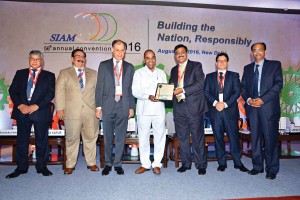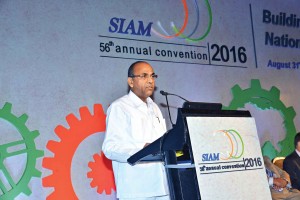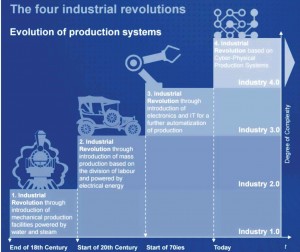At the recent SIAM annual convention, focus was on long-term policies to counter future challenges
Story : Bhargav TS
It was in 2000 that the Indian automobile industry rolled automobiles complying with BSI emission norms. Much has changed since. The industry has moved past BSII emission norms in 2002, and past BSIII emission norms in 2005. The BSIV emission norms were introduced in 2010. Their pan-India implementation is however slated for mid-2017. Unavailability of fuel proved to be a detterent for pan-India implementation. It took Europe 13 years to move from Euro1 to Euro4. In India, this journey was completed in 11 years. Work is on to meet the BSVI emission norms deadline by mid-2020. This was reflected at the 56th SIAM Annual Convention held at Delhi recently. Said a SIAM source that the industry is ready. He drew attention to the additional expenditure of Rs. one-lakh crore that may be necessary to get to a new level. The theme of the convention was, ‘Building the nation, responsibly’.
The future
In his inaugural speech, Anant Geete, the minister for heavy industries and public enterprises, expressed that the government’s move to subsidise electric vehicles, implement GST and encourage a transition to greener vehicles will ensure good growth. Hinting at the future, Geete mentioned that environment is one of the biggest concerns for the sector. “We have therefore allocated Rs.14,000 crore for the FAME scheme to promote hybrid and electric mobility. This will save Rs.60,000 crore worth of fuel, thereby benefitting the environment,” he added. Announcing that hybrid and electric vehicles are expected to dominate mobility by 2025, Geete stressed upon the key role the Indian auto industry has played in the ‘Make in India’ programme. Reiterating government support, he averred that jobs need to be created for the youth of this country. SIAM president Vinod K. Dasari, called upon the central government to support the auto industry concerning laws governing diesel vehicles, and regulate GST to ensure the auto industry is able to focus on innovation. Dasari said that the auto industry lost Rs.4000 crore in the last nine months post the ban on sale of diesel vehicles in the National Capital Region. “Such losses could be avoided if the industry gets a clear long term policy perspective,” he added.
The ban on sale of diesel vehicles above 2000cc engne was recently lifted after levying an additional one-per cent green cess, and is reflective of the challenges the Indian automotive industry is facing towards providing sustainable mobility for the masses. The industry is keen on a long-term roadmap on safety, emissions and fuel efficiency from the government. In order to make practical and rational regulations, the auto industry has been calling for the establishment of a single ministry, and a single window system. “We would like to thank the Government for accepting SIAM’s suggestion of fleet modernisation. The industry will be happy to offer incentives to customers to supplement the incentive the government will offer for the purchase of new vehicle against a scrapped vehicle,” expressed Dasari.
Global benchmarks
The session titled ‘Sustainable Mobility for Creation of Wealth of Nations’, as part of the annual convention, saw prominent industry figures participate. Discussion focused on India setting the trends – global benchmarks, rather than follow them by pursuing innovation and best practices. Gunter Butschek, MD and CEO of Tata Motors averred that the Indian economy is witnessing an unprecedented advantage compared to other countries since it is home to the world’s largest young population. “The Indian automobile industry contributes 40 per cent to the nation’s manufacturing GDP, and is surrounded by a cloud of opportunities,” he expressed. Drawing attention to challenges like safety, pollution, unemployment and lack of adequate resources, Butschek explained that it is imperative for leading automobile manufacturers to focus on developing ‘sustainable mobility solutions’ and nurture skilled engineers and people managers rather than technocrats and theory masters. “New developments like safety norms, GST and scrappage policy will be an opportunity to counter such challenges,” he added. Wilfried Aulbur, Managing Partner India, Chairman Middle East & Africa, and Head Automotive Asia, Roland Berger India, stated that the automotive industry is a significant driver for FDI in India. It also drives process improvements and quality. Aulbur stressed upon the need to stimulate volumes to boost GDP and create more job opportunities, A holistic, long-term policy is required, he opined.
In the interest of safety
Participating in a discussion under the theme, ‘Technology Trends’, Nitin Gadkari, Minister of Road Transport, Highways and Shipping, praised the auto industry’s performance and assured of his government’s support to avail new technologies. Speaking via video recorded message, he appreciated industry’s support to solve pollution problems and agree to move to BSVI from BSIV emission norms. “The automotive sector is on the road to growth and success with a turnover of Rs.450,000 crore. It is generating employment, and the government is seeking ways to ensure that a large part of the global supply can be exported from India,” averred Gadkari. He drew attention to safety, and stated that five lakh accidents take place annually, causing 2.5 lakh deaths. Calling upon the auto industry to help address the issue of accident spots across the country, Gadkari mentioned, “In 10 years, we believe India’s automotive sector will be number one in the world. To realise this goal, the industry will have to play a key role.”
Smart mobility solutions
In his address, Areil Sella, Managing Director, Capsula, called upon the Indian auto industry to come together and develop smart mobility solutions. He expressed that it is the latest and perhaps the most disruptive technology that is changing the world. Dr. Robert Stephen Moran, Deputy Head, Office for Low Emission Vehicles, Departments for Transport, Business, Energy & Industrial Strategy, Government of United Kingdom, spoke about his country’s plans to go all electric by 2040, and how they’re creating awareness among people and supporting electric vehicle production. Moran stated, that the move towards efficient models, diesel engines will play a big role in the UK. There are four policy drivers – air quality, energy security, carbon and inward investments, he informed. Drawing attention to his government’s plan of spend Euro 600 million between 2015 and 2021 to support uptake and manufacture of ultra low emission vehicles and achieve the goal of zero emission vehicles by 2040, Moran explained that the challenge is to create a self-sustaining market that is not reliant on government support.
4th Industrial Revolution
As part of the discussion under the theme, ‘Overcoming Mindsets’, John Moavenzadeh, Head of Mobility Industries, World Economic Forum on Global Trends in Mobility, USA, averred that the 4th industrial revolution is on. It is a shifting automotive game, he said. Stating that the 4th industrial revolution is not categorised by one single technology but by diverse technologies, Moavenzadeh mentioned that the global auto industry is in the midst of a more profound transformation not seen in the past 100 years. “Automotive demand is undergoing a seismic shift between developed and emerging economies. The automotive game is changing from volume to value; from the customer’s focus on the product to the mobility experience; from customer-driven vehicles to software-driven ones. By 2026, the Indian automotive industry will be among the top three in the world in the area of engineering, manufacture and export of vehicles, and components,” he added.
box
Vindo Dasari MD, Ashok Leyland has been re-elected as the president of SIAM. Ravinder Pisharody, Executive Director (Commercial Vehicles), Tata Motors, will continue to serve as the vice president of SIAM. Kenichi Ayukawa, MD and CEO, Maruti Suzuki India, continues to be the treasurer of SIAM.






















